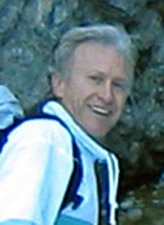Alan G. Green

The 2005 Stephan Mueller Medal is awarded to Alan G. Green in recognition of his fundamental contributions to the exploration of the structure of the crust and lithosphere at all scales and of his efforts in promoting interdisciplinary geoscience programs.
The Stephan Mueller Medal is reserved for scientists in recognition of their outstanding contributions to Tectonics and Lithospheric Geophysics. Prof. Stephan Mueller dedicated his career to seismology in the context of geodynamic / tectonic problems and demonstrated a strong commitment to interdisciplinary research by initiating and promoting international cooperation.
This year’s candidate for the Stephan Mueller Medal, Professor Alan G. Green shows great similarities, but – of course – also differences. Born in 1948 in London, Alan Green completed his studies at British universities before moving to Canada in 1973. After a one-year Postdoctoral Fellowship at the Earth Physics Branch, Ottawa, he became Assistant Professor of Geophysics at the University of Manitoba. In 1979, he accepted an invitation to become Head of the Lithospheric Geophysics Section at the Geological Survey of Canada, Ottawa. During his 19 years in Canada, he further developed and applied seismic reflection methods in investigations of the continental crust, studies associated with nuclear waste disposal and mineral exploration in crystalline terranes. Since 1992 Alan Green is professor at the ETH Zurich where he leads the Applied and Environmental Geophysics group, which strongly contributes to the development and improvement of various geophysical techniques, with a focus on 2-D and 3-D high-resolution seismics, 2-D and 3-D georadar, 2-D and 3-D resistivity and magnetic methods. Excellent quality research on the methodological aspects of seismic and other geophysical methods and attention for the wide variety of problems that can be addressed by these methods constitute the backbone of Alan Green’s very successful career. Quite characteristicically, the group’s publications appear in a wide variety of prestigious journals. The innovative way Alan Green developed and deployed the strength of geophysical methods, tailored to the problems at hand, is a sign of his mastership.
Another aspect in Alan Green’s career should be highlighted, an aspect that deserves to be valued highly: His longstanding efforts to promote and to guide research programmes in lithospheric geophysics and integrated geosciences. It started from GLIMPCE (which stands for Great Lakes International Multidisciplinary Program on Crustal Evolution) and LITHOPROBE in Canada and continued up to his presidency -in the years 1995-2000 – of the Scientific Commission on the Lithosphere and the International Lithosphere Program, and beyond. Similar to LITHOPROBE, the International Lithosphere Program addresses the nature, dynamics, origin and evolution of the lithosphere, with special attention to the continents and their margins. Particularly noteworthy and deserving special recognition is his much appreciated willingness to provide expert, insightful guidance and steering to many other national and international geoscience programs, many of which are in Europa.
In summary, specialization in combination with multidisciplinarity and integration is a key feature of Alan Green’s career. It is a very strong key with great impact on lithospheric geophysics and, in general, geosciences, and on the role of geosciences in a societal and environmental context. Professor Alan Green combines scientific excellence with broad commitment to science.
